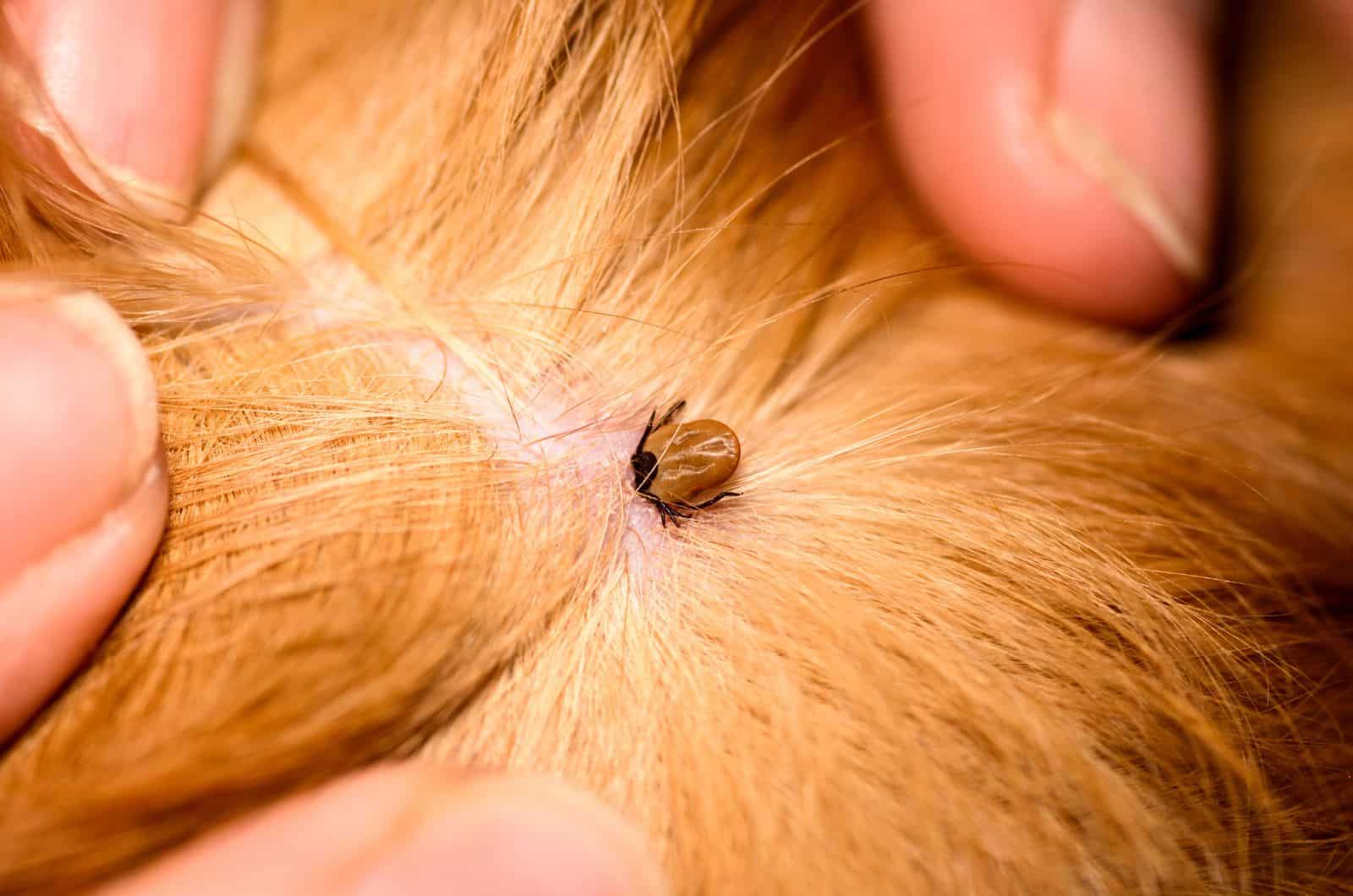Blood-sucking, vial, little creatures known as dog ticks have been around for centuries. Some records show that as a species, ticks appeared over 400 million years ago, while others claim that ticks evolved 100 million years ago.
Tick transmission to domestic dogs is a result of sharing the same environment. When you think about it, as parasites, ticks in wooded areas needed a perfect host. And, what better host than a healthy canine?
Well, it is safe that dog tick infestations are some of the leading problems dog owners and veterinarians face every day.
Not only does this tiny parasite leave a tick scab on dog, but it also causes serious health issues such as anemia, fever, and dehydration.
While the tick scab on a dog is not dangerous by itself, the tick bite is. You see, dog ticks are not what make dogs ill, it is the little protozoan parasites that live inside these ticks that cause all the trouble.
What Is A Tick Bite On A Dog?
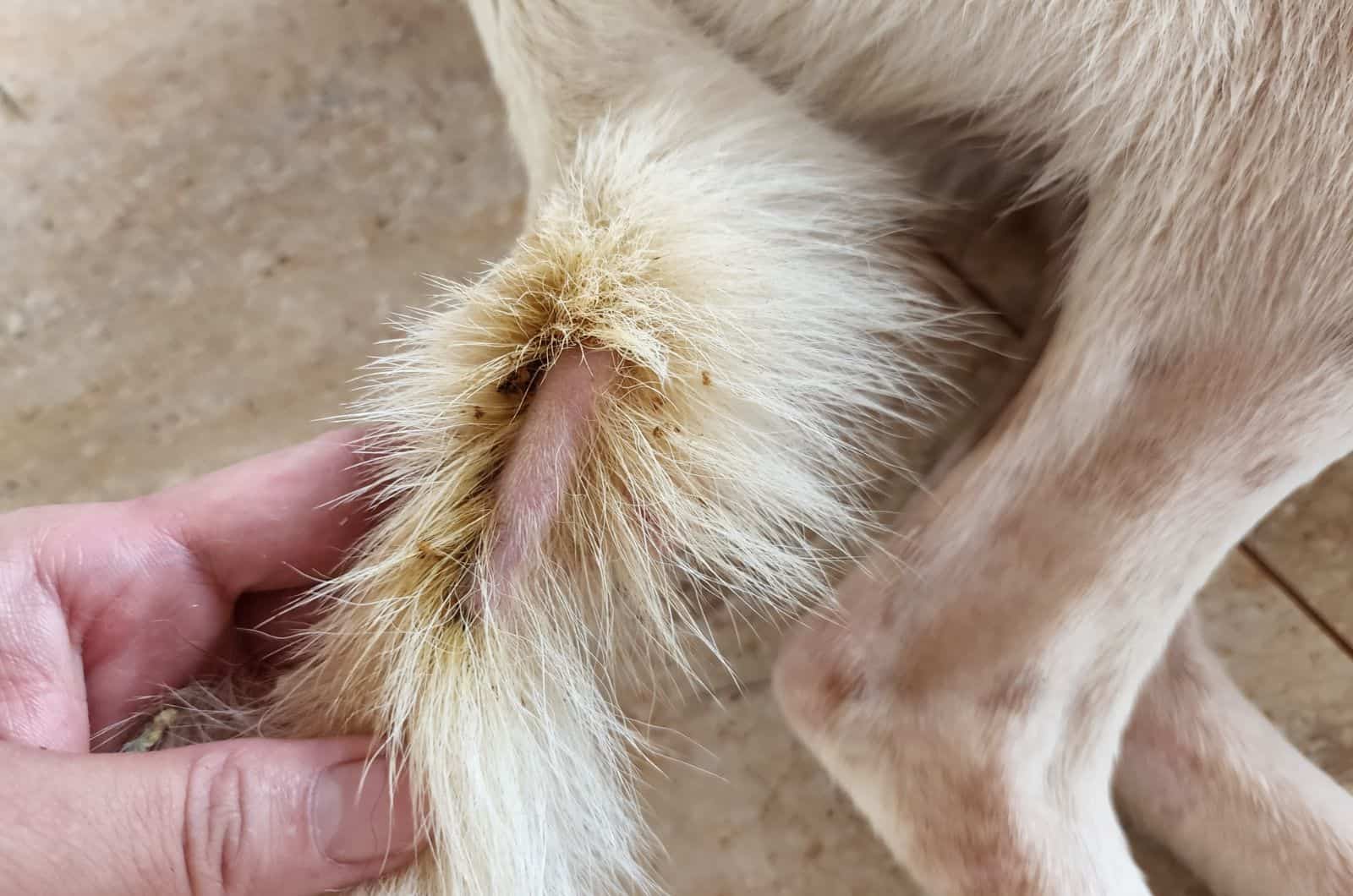
Most tick bites in dogs are painless and many dog owners fail to notice that their dog has been bitten by a tick. No wonder, because these spider-like blood-sucking pests are so small that you can barely see them!
Dog tick bites result in only minor signs and symptoms such as skin color change, swelling, or skin scabs.
However, as we’ve mentioned, some dog ticks carry pathogen protozoa and bacteria that cause illnesses such as canine Lyme disease, Babesiosis, and Rocky Mountain spotted fever.
When it appears on dogs with white and pale skin, such as the white Pug, the rash may be flat or slightly raised, and it may be pink, red, or purple.
On dogs with brown and black skin, such as black French Bulldogs, the rash may be more difficult to see and may appear as a bruise.
Does A Tick Look Like A Scab On A Dog?
Many dog owners mistake a feeding tick on their pooch for a scab, which is perfectly normal. But, there is a huge difference between a tick and a scab, especially if it is a dried tick on your dog.
Ticks that are attached to your dog’s skin can occasionally resemble small scars or scabs.
At the beginning of their feeding, ticks are super-small because their bodies are not filled with your dog’s blood (yet). As they grow, ticks get larger and start to stick out from your dog’s skin; their bodies become rounder and take a ball-like shape.
The tick may be the size of a tiny pea before eating, but after ingesting, they fill up and grow engorged. Dog ticks can grow to the size of a grape when fully fed.
All dog tick species have their similarities and differences. The similarities are that all of them like sucking blood. The major differences are in their appearance: there are black-legged deer ticks, lone star ticks, Pacific Coast ticks, brown dog ticks, and so on.
Dog scabs, on the other hand, are flatter and they stay closer to your dog’s skin.
To distinguish whether or not your dog has a tick or a crusty scab on its skin, part your dog’s fur and take a closer look. In addition to their engorged size, dog ticks are attached to their tiny mouth and legs, so you will be able to see that too.
What Does A Tick Bite Look Like On A Dog?
Only the tick’s head contains the parasite that enters your dog’s body. Therefore, it’s unlikely to be a tick if you notice a bump that looks like it’s under the skin.
But if you notice something that seems to be protruding from your dog’s skin, it might be a tick.
A dog’s tick bite resembles a tiny red bump, much like a mosquito bite. At the site of a dog tick bite or tick removal, a small, red bump will appear, similar to a dog’s scab.
After you have taken the tick out from your dog’s skin, a rash is one of the side effects that can appear within a month of infection. These lumps frequently develop at the site of a tick bite or removal and disappear over the course of a few days.
What Does A Tick Wound On A Dog Look Like?
Usually, two to four days after the tick bite, if removed improperly, redness begins to show up close to the tick bite site and then gradually spreads to cover a sizable area.
When you remove a tick from your dog, there is a chance that a red rash will develop in the next few days. Dog’s tick rash looks like tiny red spots.
You will notice a flat, itchy skin lesion that ranges in size from less than 0.25 inches to 0.33 inches and makes up each red spot. Your dog is going to scratch the tick bite pretty often.
Is It Normal For A Tick Bite To Scab Over?
The amount of scabbing is typically quite minimal and resolves within a few days for an uninfected tick bite (in which no harmful bacteria or disease-causing microorganisms were transmitted).
Knowing how to recognize a bite is essential because treating and preventing these bites can help keep your dog from contracting unpleasant tick-borne illnesses like canine Lyme disease.
These blood-sucking pests infiltrate your dog’s skin and there can be so many of them at the same time that it may appear that there are many scabs over your dog’s body. But, take a closer look and you will be able to distinguish whether it is a scab or a dog’s tick.
What Does It Look Like After A Tick Is Removed From A Dog?
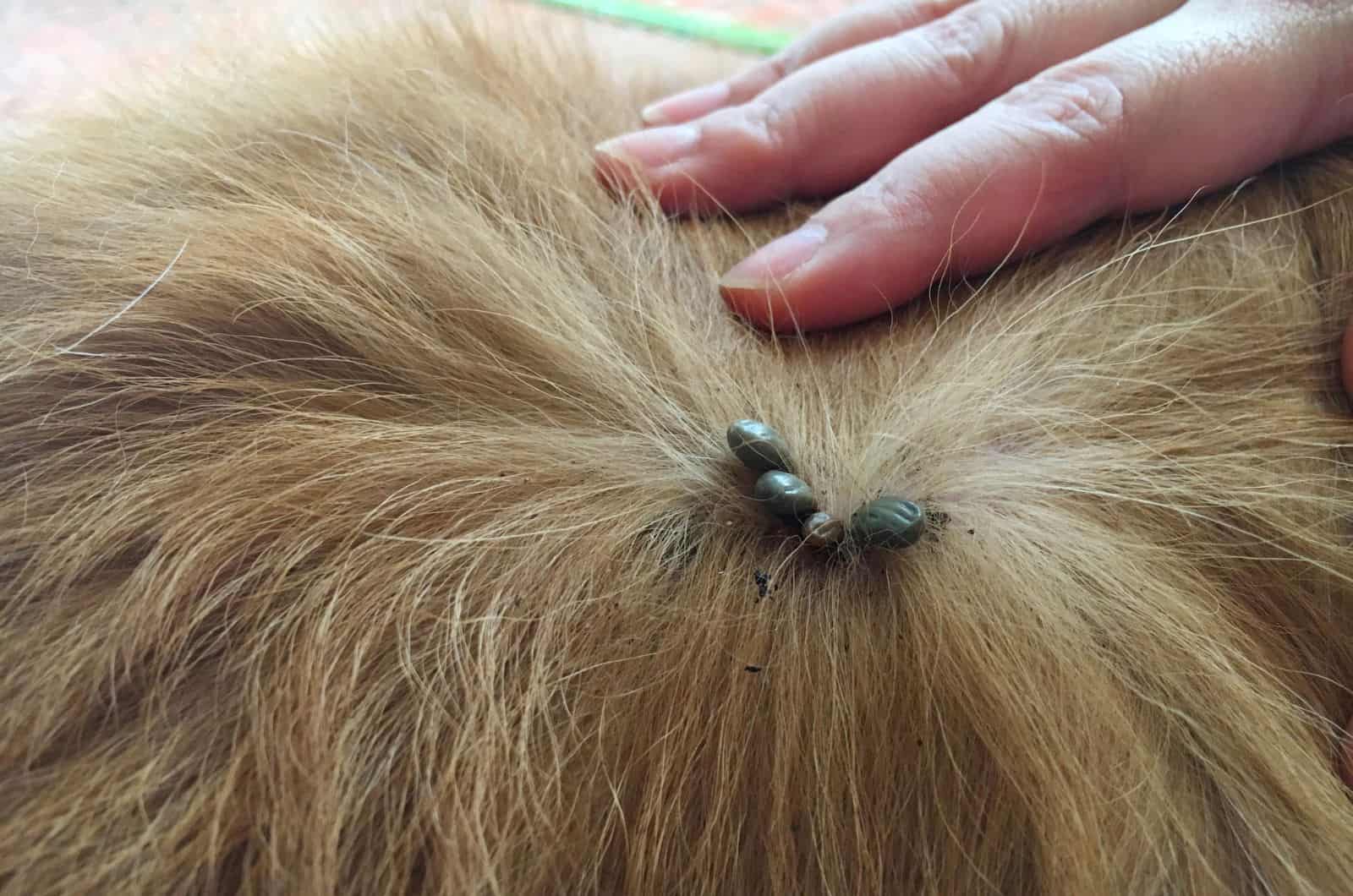
When you split your dog’s hair, look for a red bump that is surrounded by clear skin and has an expanding red rash around it. This is visible upon the dog’s tick removal and it can last for the first two weeks following a tick bite — like a little, red skin tag.
Watch out for flu-like symptoms your pooch may exhibit such as:
• Elevated body temperature (fever)
• Nausea
• Lethargy
• Change in urine color
• Change in skin tone
• Loss of appetite
• Itchiness
• Lameness
• Dry nose
• Enlarged lymph nodes
There might be a tiny red bump visible on your dog’s skin after the tick falls off. This is because the dog’s body reacts to the tick’s saliva and develops red bumps, spots, or crusty scabs.
Some dogs may develop crusty scabs around the mouth, but that can be due to other health issues.
If you suspect any signs of infection on your dog’s skin and that the tick bite wound is infected, call your veterinarian (DVM).
Do Ticks Leave Scabs On Dogs?
There are various types of ticks in dogs that leave different skin tags after their removal. Some dog tick species can get infected with dangerous protozoa, viruses, and bacteria. Types of ticks such as Rickettsia parkeri (brown dog tick) cause Rickettsiosis in dogs, which is often known as Rocky Mountain spotted fever.
Dogs with Rickettsiosis often have dark, crusty scabs that form at the site of a tick bite. They typically appear one to seven days after being bitten by an infected tick or mite.
My friend’s dog, a purebred Labrador Retriever, had a persistent tick bite scab on one of its front legs. She was not sure what to do, so she contact our clinic in hopes of finding answers.
After Milo, the Lab was administered in the clinic we gave him a full examination and figured it had a tick’s head stuck in its skin. My friend was not successful in removing the head, and the dog’s skin started to surround the inflamed site where the tick’s head is located.
This was a good sign because Milo’s body started to eliminate the foreign body (tick’s head) by itself. We boosted his immune system with vitamins and supplements and administered topical ointment which soothed his skin.
For the following few days, Milo’s tick scab was itchy, so we wanted to check if Milo had any other symptoms that could indicate a tick-borne disease. Luckily, Milo was all clear and healthy!
What Is A Scab From A Tick Bite Called?
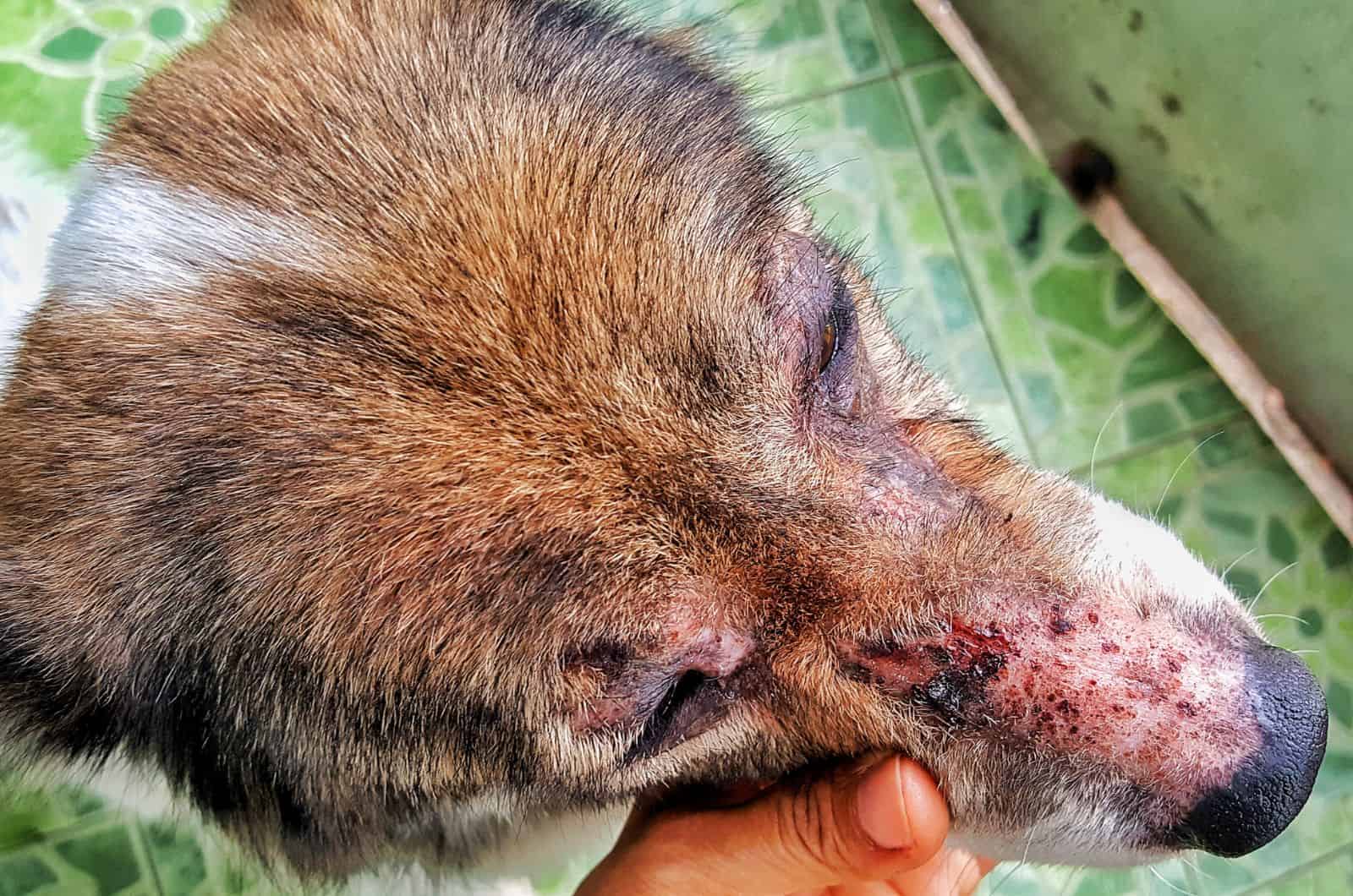
You’d be surprised that even a scab from a tick bite has its name and it is called an “Eschar”. It is described as dead tissue that sheds or comes off the dog’s skin.
It frequently occurs with wounds from other types of wounds like those from uncomfortable bedding (if a heavy dog sleeps on solid concrete), we call those pressure ulcers.
Depending on how deep they are and how much skin tissue is affected, tick scab wounds are divided into stages. A dog’s eschar can be crusty and it typically changes color: tan, brown, or black.
Dog’s eschar is a buildup of dead tissue that is flush with the skin’s surface within the wound. The removal of stable, dry, and adherent eschar is not recommended. Just leave your dog’s skin alone and it will shed and heal by itself.
Make sure that your dog gets enough water because the infection is made more likely by poor blood flow beneath the eschar.
What Should You Do If You See A Scab On Your Dog?
As we love to say here at PupVine — don’t panic! You get nothing out of panic, especially when it comes to this dog tick problem.
We prepared a bunch of tips and tricks to help worried dog owners care for tick scabs on their dogs. Read carefully and don’t miss any dog tick removal details!
Trim The Hair Around The Tick Bite
After you or your veterinarian has determined what caused the scab, you should gently trim the hair around the wound.
This should allow you to get a better look at the skin and determine the true size of the affected area. Trimming also improves airflow and promotes drying, which is important because bacteria thrive in damp or wet environments.
Wash The Dog’s Tick Wound
Thorough cleaning of the dog’s tick wound with soap and water is a good way to get rid of dirt, allergens, and other irritants that might be causing it to lick, scratch or bite the wound.
For the majority of dog tick scab wounds, warm tap water is advised. You could also use a warm water-salt solution.
A quick bath may also momentarily ease your dog’s discomfort which is caused by a burning or itching sensation.
When a dog’s scab is ready to come off naturally, moistening it can make it do so without the need for yanking or rubbing.
Nothing else should be used to clean the wound unless your veterinarian has given the green light to do so. Even veterinary antiseptics can delay dog tick scab healing.
The choice of dog shampoo can have a significant impact on the tick scab treatment’s efficacy. The ingredients in various products can cause allergies in dogs and some shampoos are designed to treat particular skin conditions.
Generally speaking, it’s best to stick with products that don’t contain any additional perfumes or dyes because these can irritate Fido’s skin.
Apply Topical Anti-Itch Medication
Once the scab is moist and soft, apply an anti-itch or antibiotic spray to it (only if your vet said yes). Use a topical ointment to treat the dog’s scabbed area. The scab will most likely slough off on its own if you use an ointment.
However, topical creams and ointments are tricky to administer to dogs because they always lick them off.
Medication such as Apoquel is often given to dogs to relieve their itching issues. While these can be found on Amazon, for the proper dosage and course of treatment, consult your veterinarian. Your vet may also suggest some oral medications if your dog is feeling under the weather after tick removal.
Let The Tick Scab On Dog Breathe
Allow the dog tick scab to breathe! Do not cover it with bandages because lots of moisture will accumulate and slow down the healing process.
Your dog’s skin requires airflow to stay healthy and to help dry out any dampness from the tick scab.
To protect your dog’s skin from additional skin infections, you can cover your dog’s scab loosely with sterile gauze. This will act as a physical barrier but it will also help your dog’s skin to breathe.
Do Not Try Home Remedies
I know that you are probably tempted to search for home remedies for tick scabs on dogs, but please do not do this. I recently found out that dog owners put apple cider vinegar on their dog’s scabs, and this is a huge no-no.
A little apple cider vinegar in your pup’s water may help with some of these issues, such as dry skin and slight indigestion, but for more serious wounds that will result in large scabs, stick to standard treatments and take your pooch to the vet.
If your dog exhibits symptoms of scabs that won’t go away on its own, always seek a professional diagnosis from your veterinarian, as is the case with any wellness issues involving your Fido.
In addition to its ability to moisturize skin, cocoa butter also has a beneficial rubbing effect, but it may worsen a skin infection if improperly applied.
Do Not Remove Tick Scab On Dog
Pulling off the tick scab from your dog earlier than it is supposed to fall off could reopen a wound and make them feel worse. If you pull out a scab, your dog may feel nauseous and may gag, but not throw up, which means that it is in pain.
In some cases, leaving a scab in place will help the area heal, but in other cases, having a scab will slow the healing process and it will be quicker to remove the scab.
It is preferable to discuss this with your veterinarian and figure out whether or not the tick scab on your dog needs to be removed.
How Is A Tick Removed From A Dog?
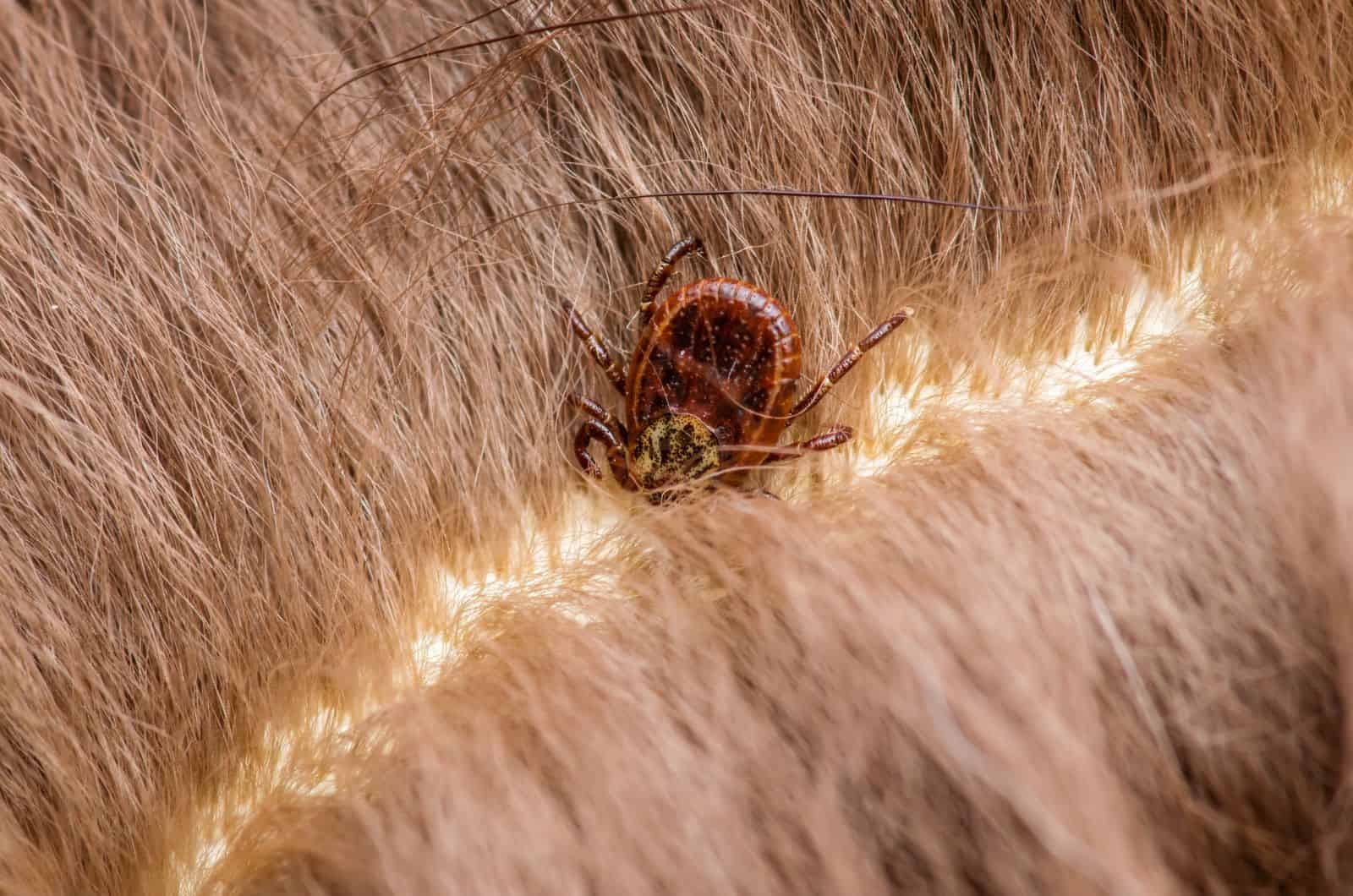
Tick removal in dogs is pretty easy, but if you don’t pay attention, you can make a mistake. By the mistake I mean when removing a tick, you can easily detach its body from its head which will leave the tick’s head inside your dog’s skin. This can cause skin infections and scabs.
No matter the dog breed, you need to be careful not to leave the tick’s head and mouth on your dog’s skin. Chances are that this will happen, especially if you are removing the tick for the first time.
Don’t worry, it is not the end of the world if you fail to remove your dog’s tick properly. The dog’s skin will take on its protective role, and over time, push the tick’s head and mouth out.
But, you should know how to properly extract a tick from your dog, and we’re here to show you!
Take Your Trusty Tweezers
This is literally the single, best tick-removal tool that you have lying around your house. But, you can also buy professional tick removal tools — special tick tweezers that you can find on Amazon.
Let’s get straight to business!
Take hold of the tick as close to the skin’s surface as you can using clean, fine-tipped tweezers. Apply consistent, even pressure as you pull up. Avoid twisting or jerking the tick’s body because doing so could result in the mouthparts breaking off and staying in the skin.
If this occurs, use tweezers to remove the mouthpieces. Maintain your composure and carefully pull any surrounding dog’s hair back to reveal the skin where the tick bit him.
Put your dog’s skin as close to the tick as you can (without pinching your dog). Pull it out slowly and steadily in a straight line.
Clean The Dog Tick Bite Area
After removing the dog tick, use rubbing alcohol, soap, or lukewarm water to thoroughly clean the dog tick bite area and your hands.
Use a sterile gauze whose size will depend on the size of the dog tick and the tick bite area
Dispose Of The Dog Tick
A live tick should be disposed of by immersing it in alcohol, placing it in a sealed bag/container, tightly wrapping it in tape, or flushing it down the toilet. However, the best idea would be to save the dog’s tick. The reason why is to have your veterinarian examine the tick to determine if any dangerous disease transmission is possible.
Never break it with your fingers, and naturally, you should watch out for any lingering symptoms your dog may exhibit in the following weeks. Common symptoms to look out for after removing dog ticks is your dog refusing to walk, having a skin rash, fever, or lethargy.
Another useful tip is to label the container with the date of removal and the location of the tick on your dog’s body.
After determining the type of tick, your veterinarian will advise you on the symptoms to look out for in your pet. They may advise diagnostic testing at a later date (usually 45-60 days after the tick bite) to rule out disease transmission.
When Is Dog Tick Season?
Dog tick exposure can occur at any time of year, but these pesky blood-sucking creatures are most active during the warmer months. That said, dog tick season usually lasts from March to October, but it can last longer, especially due to frequent climate change.
Dog ticks absolutely love wet weather and warmer temperatures — it keeps them vital and active for longer periods of the year.
As a general rule, dog ticks are active whenever the temperature rises above freezing.
Adult dog ticks are most active from March to mid-May and from mid-August to November. Canine Lyme disease can be transmitted by two tick life stages: nymphs and adults.
Dog ticks are something dog owners should be concerned about all year long because some tick bite symptoms in dogs, such as skin problems, lameness, and lethargy, can take two to three months to appear.
Conclusion
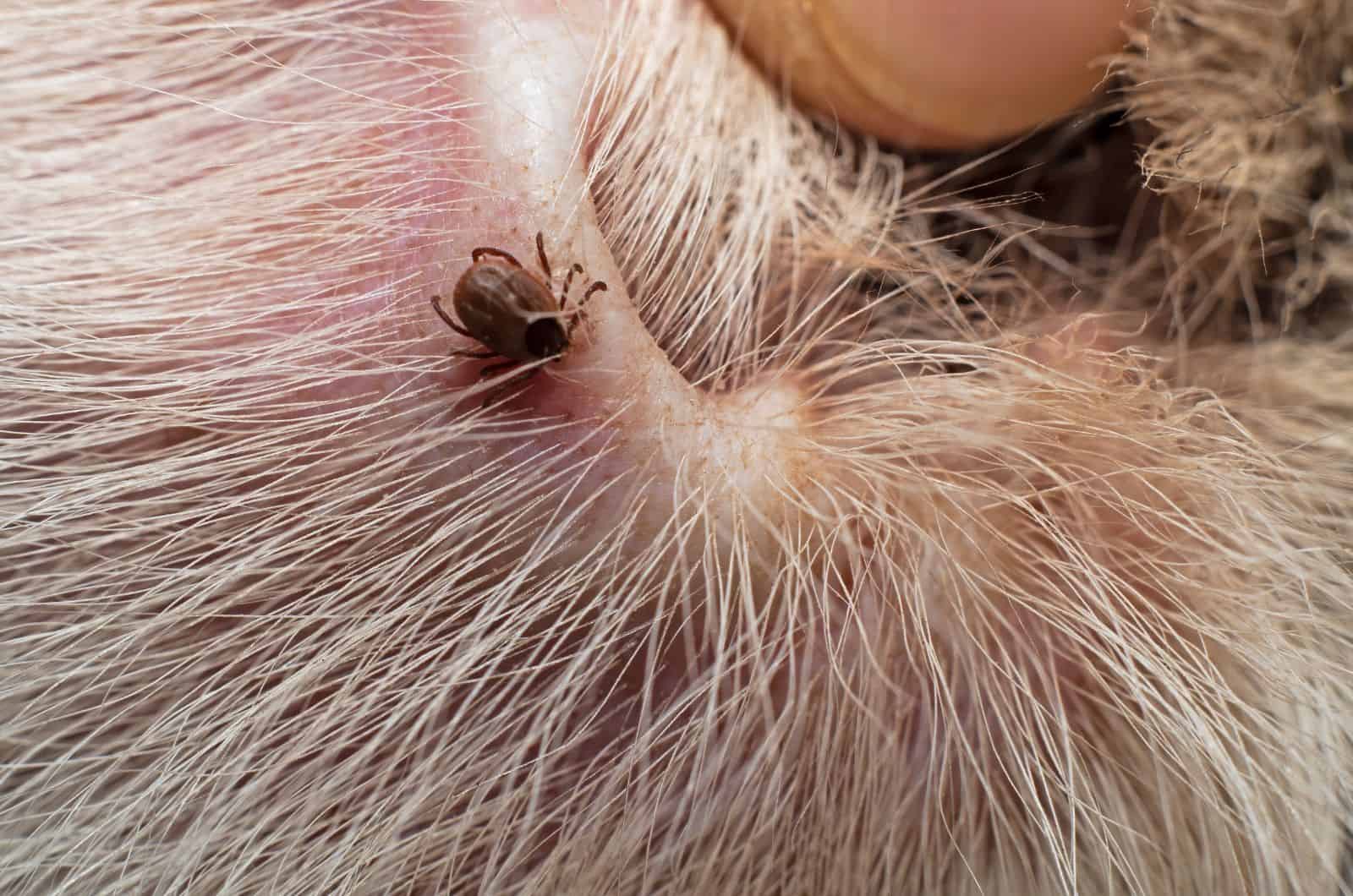
Your dog will be protected from ticks and harmful diseases all year long if you use the right flea and tick prevention medication. Dog spot-on flea treatments are great for keeping them safe from dog ticks that lurk in grassy and wooded areas.
Make sure to conduct frequent and thorough tick checks, especially if you live in or occasionally take your canine companion to grassy or wooded areas.
We have provided you with tips and tricks on dog tick removal, so in conclusion, we want you to know how to properly remove and dispose of ticks. As soon as you see a dog tick, remove it. The sooner you remove it, the less likely it is that the disease will spread.
This way you will be able to safely enjoy the outdoors with your furry friend.
If you happen to notice a tick scab on a dog afterward, don’t worry. Simply follow this guide and stay in contact with your vet.
Related Content
A White Spot On Dog’s Nose Requires Shampoo And A Hose
